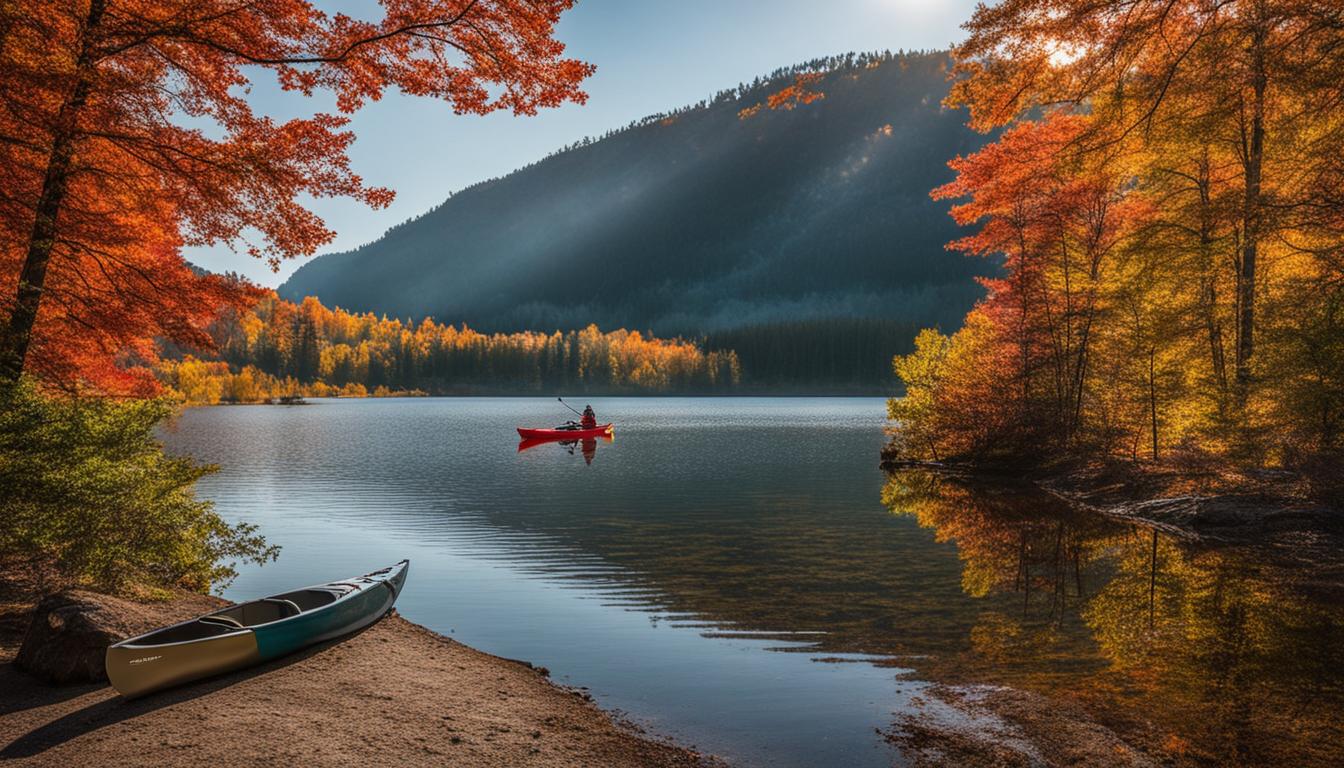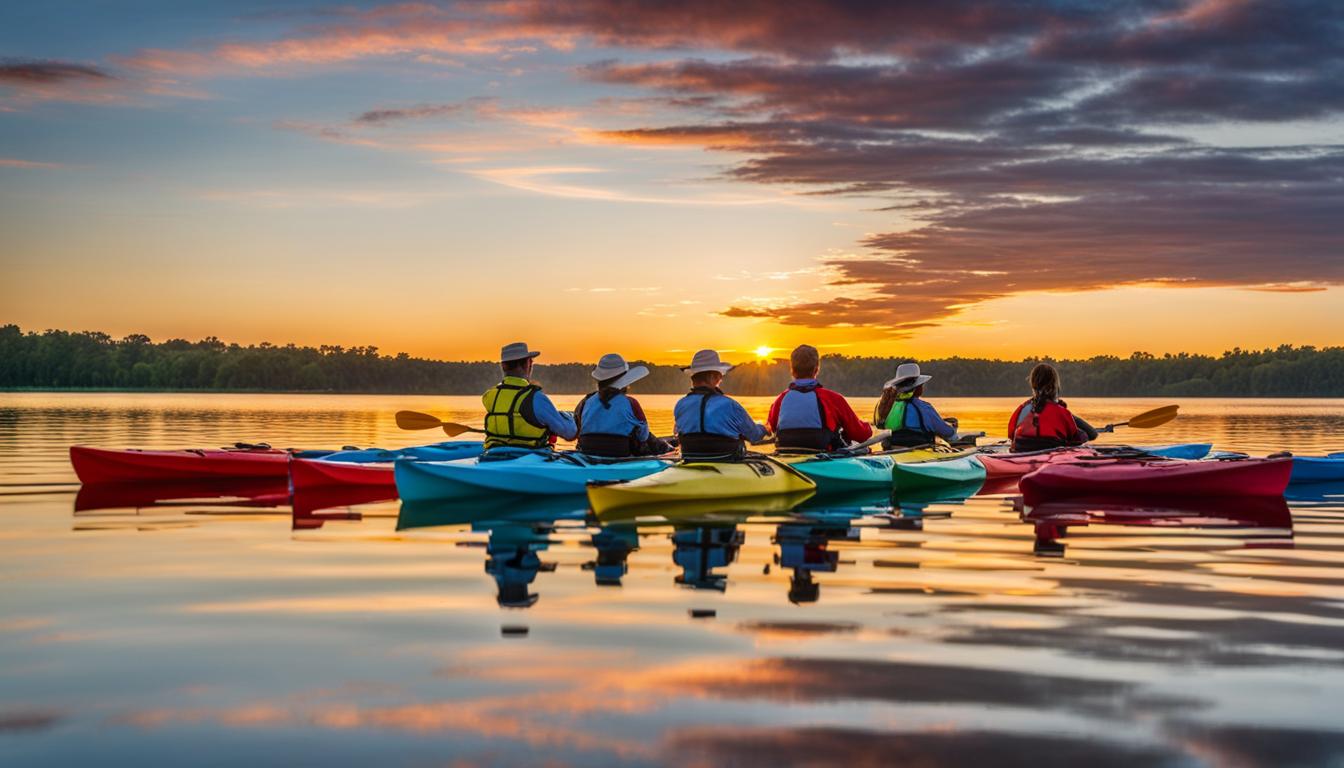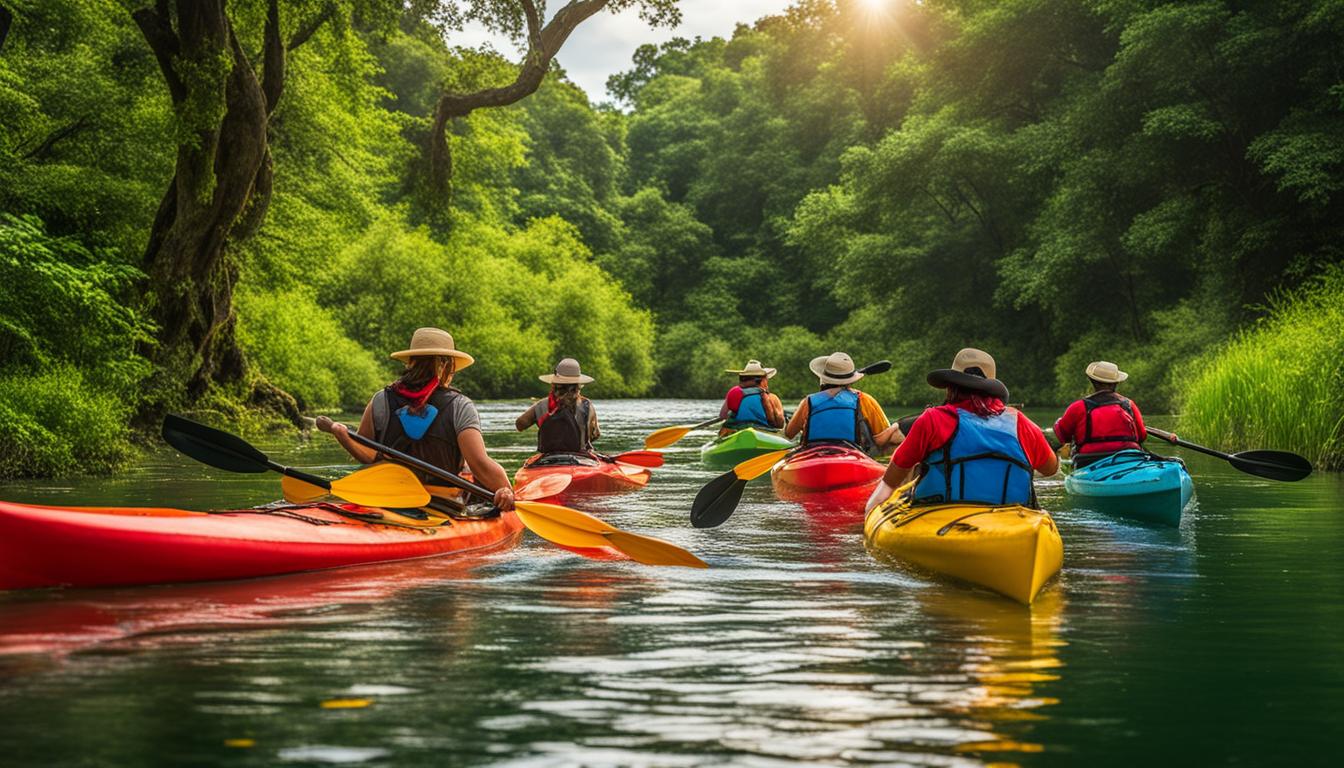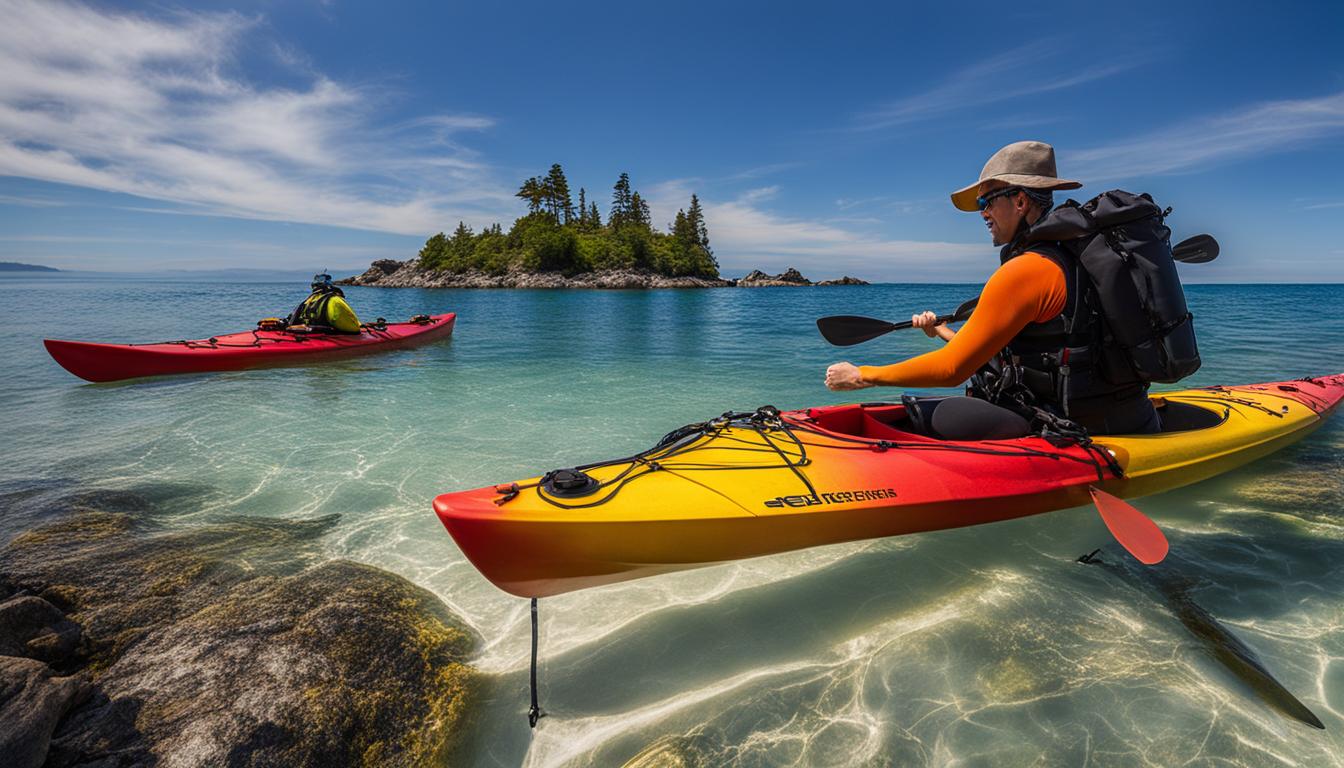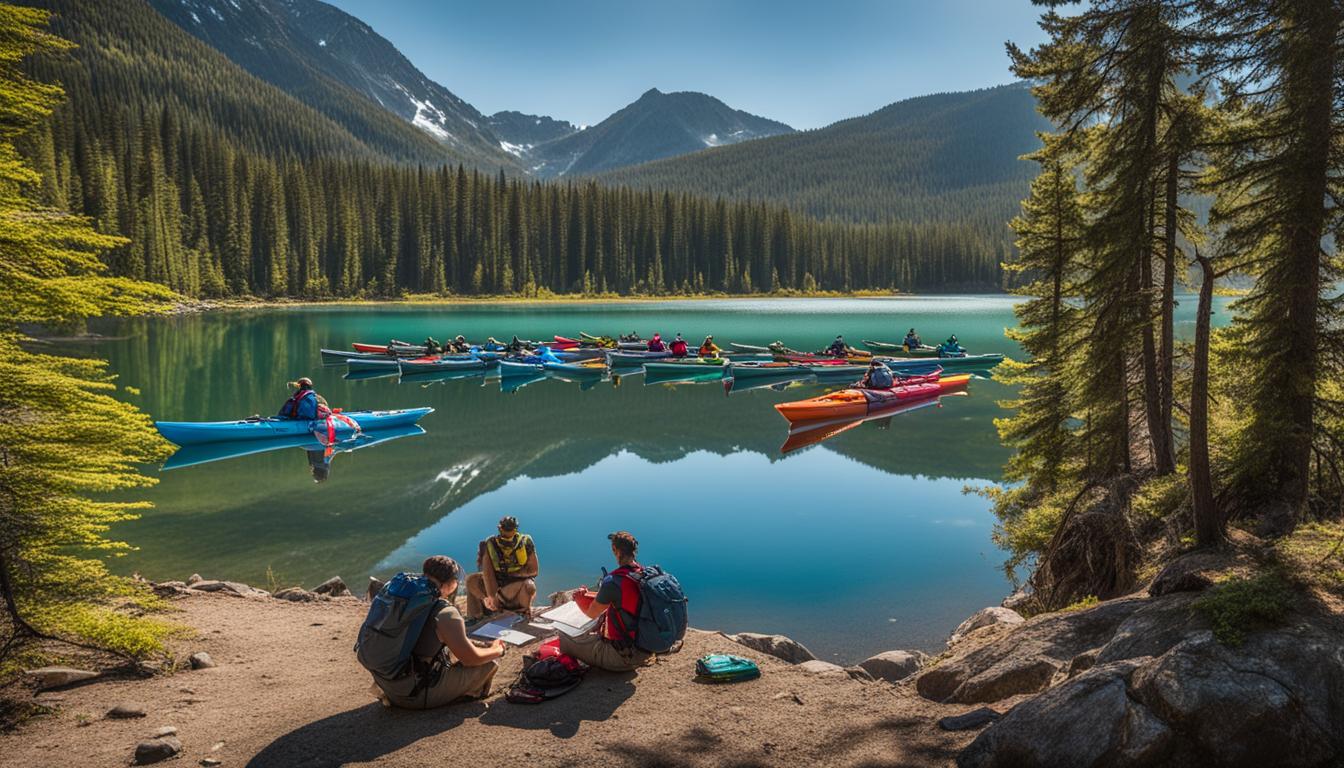When planning a kayak camping trip, it’s important to take into account the seasonal considerations that can affect your experience. Whether you’re planning to go kayak camping in the spring, summer, autumn, or winter, there are specific tips and considerations to keep in mind.
In the spring, be prepared for unpredictable weather and colder water temperatures. Summer brings warmer weather, but also more crowded waters and the need to pack lighter due to limited space in your kayak. Autumn offers beautiful foliage but also the challenge of colder temperatures and shorter daylight hours. Winter kayak camping comes with its own set of challenges, including freezing temperatures and the need for specialized gear. By adapting your kayak camping to the different seasons and being aware of the specific weather conditions and wildlife activity, you can have a safe and enjoyable experience in any season.
Key Takeaways:
- Each season presents unique challenges and considerations for kayak camping.
- Spring brings unpredictable weather and colder water temperatures.
- Summer is the peak season, with more crowded waters and limited space for packing.
- Autumn offers beautiful foliage but also colder temperatures and shorter daylight hours.
- Winter kayak camping requires specialized gear and precautions for freezing temperatures.
Spring Kayak Camping Tips: Navigating Unpredictable Weather and Cold Waters
When planning a kayak camping trip in the spring, it’s essential to consider the unique challenges posed by unpredictable weather and cold waters. As the seasons transition, you can expect sudden changes in weather conditions, such as rain showers and wind gusts. To ensure your safety and enjoyment, it’s crucial to be prepared and take the necessary precautions.
Pack for Changing Weather
Dress in layers and bring waterproof clothing to protect yourself from the elements. Start with a moisture-wicking base layer to keep you dry and insulated. Layer on a fleece or lightweight jacket for added warmth, and top it off with a waterproof shell to shield against rain and wind. Don’t forget to pack a brimmed hat and sunglasses to protect yourself from the sun.
Be Aware of Water Temperature
Spring waters can still be quite chilly, so it’s essential to take precautions to avoid hypothermia in case of immersion. Choose a kayak with a stable design to minimize the risk of capsizing. Consider wearing a wetsuit or drysuit for added insulation and protection. It’s also a good idea to bring a change of clothes in a waterproof bag, just in case.
Check the Weather Forecast
Prior to setting out on your kayak camping adventure, be sure to check the weather forecast. Keep an eye out for any potential storms or severe weather conditions that could make paddling unsafe. It’s always better to have a backup plan and reschedule if needed. Your safety should always be your top priority.
| Key Tips for Spring Kayak Camping |
|---|
| Dress in layers and bring waterproof clothing |
| Be aware of the water temperature and the risk of hypothermia |
| Choose a stable kayak design and consider wearing a wetsuit or drysuit |
| Check the weather forecast before heading out |
By following these spring kayak camping tips, you’ll be well-prepared to navigate the unpredictable weather and cold waters. Remember to always prioritize safety and make informed decisions based on the current conditions. With the right gear and knowledge, you can have a fantastic experience exploring the beauty of the great outdoors during the spring season.
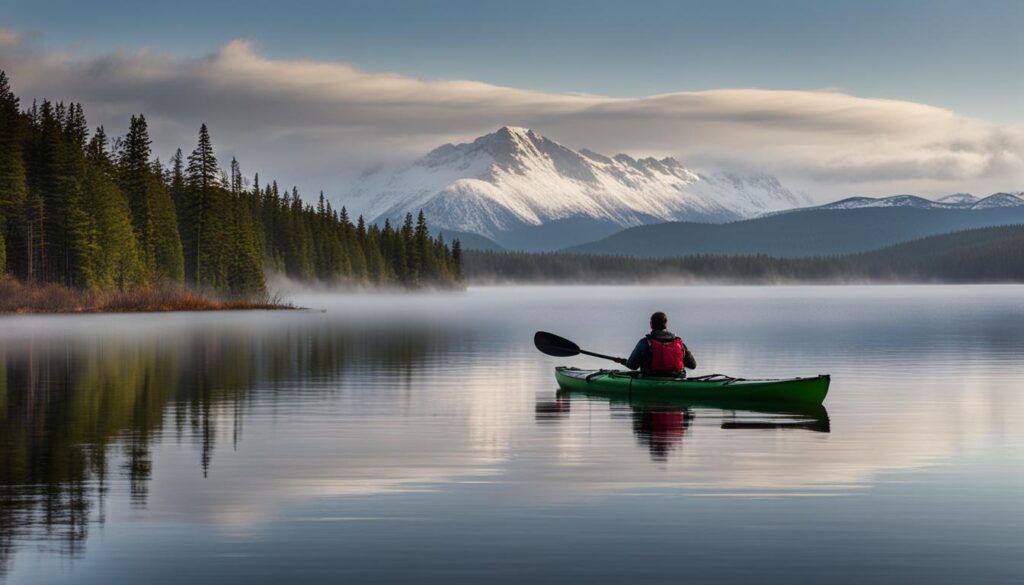
Summer Kayak Camping: Beating the Crowds and Packing Light
Summer is the perfect season for embarking on a kayak camping adventure. With warmer weather and longer daylight hours, you have more time to explore and enjoy the beauty of nature. However, it’s important to adapt your kayak camping experience to the specific challenges and opportunities that summer brings.
One of the main considerations during summer kayak camping is beating the crowds. Popular kayaking destinations can become overcrowded, making it difficult to find a secluded spot for camping. To avoid this, consider exploring lesser-known or remote locations. These hidden gems often offer tranquility and a more intimate connection with nature.
When packing for summer kayak camping, it’s essential to be mindful of limited space in your kayak. Packing light is the key to a comfortable and enjoyable trip. Prioritize essential items, such as food, water, and safety gear. Leave behind unnecessary items that can weigh you down. Remember, the lighter you pack, the easier it will be to maneuver your kayak and navigate through the water.
Seasonal Wildlife and Kayak Camping Destinations
Summertime also brings unique wildlife encounters. Birds nesting, fish migrations, and other seasonal wildlife activities add to the excitement of your kayak camping experience. Before setting out, research the seasonal wildlife in the area you plan to explore. This will allow you to plan your routes accordingly and increase your chances of spotting fascinating creatures in their natural habitats.
To make the most of summer kayak camping, take advantage of the season’s best destinations. From serene lakes to winding rivers, there are countless options for exploration. Some popular kayak camping destinations during summer include Boundary Waters Canoe Area Wilderness in Minnesota, Everglades National Park in Florida, and Apostle Islands National Lakeshore in Wisconsin. Each of these locations offers breathtaking scenery and opportunities for memorable paddling adventures.

| Destination | Location | Highlights |
|---|---|---|
| Boundary Waters Canoe Area Wilderness | Minnesota | Untouched wilderness, pristine lakes, and abundant wildlife |
| Everglades National Park | Florida | Mangrove forests, diverse ecosystems, and unique wildlife |
| Apostle Islands National Lakeshore | Wisconsin | Scenic sea caves, sandy beaches, and historic lighthouses |
In Summary
When planning your summer kayak camping trip, remember to beat the crowds by exploring lesser-known destinations. Pack light, prioritizing essential items, and leave unnecessary items behind. Research the seasonal wildlife in your chosen area to enhance your nature encounters. Finally, choose the best summer kayak camping destinations that offer stunning landscapes and unique experiences.
Autumn Kayak Camping Tips: Embracing Nature’s Beauty and Preparing for Colder Temperatures
Autumn is a beautiful time for kayak camping, with the changing colors of the foliage creating a stunning backdrop. However, it also comes with colder temperatures and shorter daylight hours. When planning an autumn kayak camping trip, be prepared for chilly mornings and evenings by packing warm layers and a good sleeping bag. Consider investing in seasonal gear, such as insulating sleeping pads and lightweight, but warm, waterproof clothing. Take advantage of the quieter camping season and explore scenic areas that are less crowded than during the summer. Be aware of wildlife activity, such as migratory bird patterns or the rutting season for deer, and plan your trips accordingly.
When it comes to gear, there are a few key essentials to pack for autumn kayak camping. In addition to your usual camping equipment, make sure you have a reliable stove or campfire cooking setup to keep warm and prepare hot meals. Don’t forget to bring a portable water filter or purifier, as water sources may be more limited or have increased sediment during the autumn months. It’s also a good idea to have a quality headlamp or flashlight for navigating in the darker evenings. And of course, don’t leave behind your camera to capture the breathtaking fall scenery.
As the weather can be unpredictable during autumn, it’s important to check the forecast before embarking on your kayak camping trip and be prepared for sudden changes in conditions. Dress in layers that can be easily adjusted throughout the day to regulate your body temperature. Bring a waterproof shell or rain jacket to protect yourself from rain showers and pack extra dry clothing in case you get wet. Remember to stay hydrated and fuel up with energizing snacks to keep your energy levels up during your outdoor adventures.
Overall, autumn kayak camping offers a unique and rewarding experience. Enjoy the beauty of nature’s changing colors, embrace the peacefulness of quieter camping destinations, and be prepared for the cooler temperatures and shorter daylight hours. With the right gear and mindset, you’ll have an unforgettable autumn kayak camping adventure.
Table: Essential Gear for Autumn Kayak Camping
| Item | Description |
|---|---|
| Warm Layers | Insulating clothing to keep you warm in chilly temperatures |
| Sleeping Bag | A quality sleeping bag rated for colder temperatures |
| Insulating Sleeping Pad | To provide insulation and cushioning from the cold ground |
| Waterproof Clothing | Lightweight, waterproof clothing to stay dry in case of rain |
| Stove or Campfire Cooking Setup | To prepare warm meals and beverages |
| Portable Water Filter or Purifier | To ensure a safe and clean water source |
| Headlamp or Flashlight | For navigating in darker evenings |
| Camera | To capture the stunning autumn scenery |
Winter Kayak Camping Challenges: Overcoming Freezing Temperatures and Specialized Gear
Kayak camping in winter brings its own set of unique challenges that require careful preparation and specialized gear. The freezing temperatures demand proper insulation to keep you warm and safe during your adventure. To adapt your kayak camping to the winter season, invest in a high-quality drysuit or wetsuit to protect yourself from the cold water. Layering is key, so be sure to pack insulating clothing, such as thermal base layers, fleece jackets, and waterproof outer shells.
When selecting a destination for winter kayak camping, opt for secluded spots that are less crowded compared to other seasons. These tranquil hideaways not only offer a peaceful experience but also reduce the risk of encountering ice hazards on heavily trafficked waterways. However, it is crucial to assess the ice thickness before venturing out, ensuring your safety remains a priority throughout your trip.
Adapting to the challenges of winter kayak camping also involves being prepared with the right equipment. In addition to appropriate clothing, consider packing cold-weather camping gear such as a four-season tent, a sleeping bag with a low temperature rating, and an insulated sleeping pad. These items will help keep you comfortable and protected even in freezing conditions. Remember, safety should always come first, so ensure you have the necessary skills and experience to navigate winter waterways before embarking on your journey.
Winter kayak camping may have its challenges, but it also offers a unique opportunity to explore serene and less-traveled destinations. By adapting to the season and being equipped with the right gear and knowledge, you can embark on a memorable winter kayak camping experience that showcases the beauty of nature in a whole new way.
FAQ
What should I be prepared for when kayak camping in the spring?
When kayak camping in the spring, be prepared for unpredictable weather and colder water temperatures. Dress in layers, bring waterproof clothing, and consider wearing a wetsuit or drysuit for added insulation. Check the weather forecast before heading out and have a backup plan in case conditions become unsafe.
How can I beat the crowds and pack light for summer kayak camping?
To beat the crowds, consider exploring lesser-known or remote kayak camping destinations. Pack light and prioritize essential items, such as food, water, and safety gear. Be aware of seasonal wildlife activity and plan your routes accordingly.
What should I keep in mind when planning an autumn kayak camping trip?
When planning an autumn kayak camping trip, be prepared for colder temperatures and shorter daylight hours. Pack warm layers and a good sleeping bag, consider seasonal gear, and take advantage of the quieter camping season. Be aware of wildlife activity and plan your trips accordingly.
What are the challenges of winter kayak camping?
Winter kayak camping presents unique challenges including freezing temperatures and the need for specialized gear. Have the right equipment, check ice thickness before venturing out, and prioritize safety. Winter is a great time to explore secluded kayak camping destinations that are less crowded.

